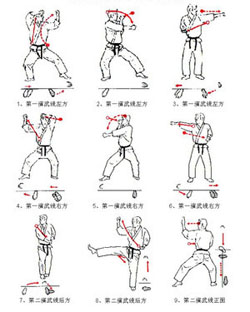 THE DIFFERENT KARATE SCHOOLS
THE DIFFERENT KARATE SCHOOLS
The Chinese fighting art known as Shaolin was imported to Okinawa, and merged with the fighting techniques of the island natives. Style: Each teacher generally follows a specific style. The beginner is still foreign to this concept, there will always be time to change style once the perception of karate has been refined. Even practicing 1 trial class will not allow a novice to appreciate the differences in style. Today, there are twenty-four schools, four of which are among the most important. They all try to distinguish themselves not only by characteristic techniques, positions and kata but also by a different philosophical approach:
Shotokan:
Created and developed by Master Funakoshi Ginchin. The movements are linear, the postures fairly low. With the speed of execution, the long and powerful attacks and the agility of the movements, Funakoshi Yoshitaka, successor and son of Funakoshi will add more and more low positions. There are a number of styles of karate, such as Wadō-ryū, which originate from Shotokan. What could set the Shotokan style apart from the others are the low positions, the rigidity of the techniques and the traditionalism of training.
Shito-ryū:
This style comes from both Shuri-te and Naha-te. Founded by Master Mabuni, it is marked by subtlety and speed. The techniques are based on the mobility of the pelvis, the movements of the body and the deviation of the attacks. The three aspects that define karate, shu (spirit), gi (technique), and taï (body), must be constantly worked on.
Gōju-ryū:
Founded by Master Miyagi Chôjun, back from a trip to China, it has its origins in Naha-te. It is characterized by realistic movements in contraction and strength, by short techniques performed from high positions. The blockages, often performed with open hands, are circular and without shock. This style emphasizes the importance of inner energy perceptible by proper breathing. Go means "hard" and ju means "soft", so Gōju-ryū is the transcription of a path that is both soft and hard. Dynamic tension and adapted breathing constitute its two bases of reference
Wadō-ryū:
"The Way to Peace School" was founded by Otsuka Hironori, a student of Funakoshi Gichin. He combined with movements of Ju-jutsu (technique of flexibility) those of blockages of Okinawa. Created from the Shotokan style and Ju-jutsu, it is inspired by Shuri-te and highlights evasion and flexibility. This style is intended to be penetrating, combat-oriented and based on forward lunge positions. The work of the hips pulled and not pushed is typical. It excludes kicks and emphasizes flexibility.
